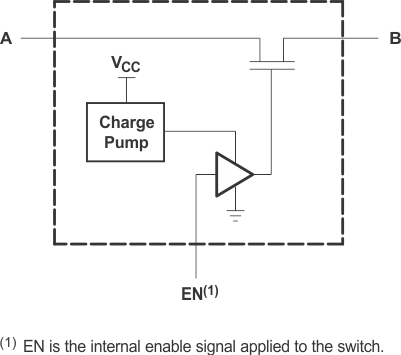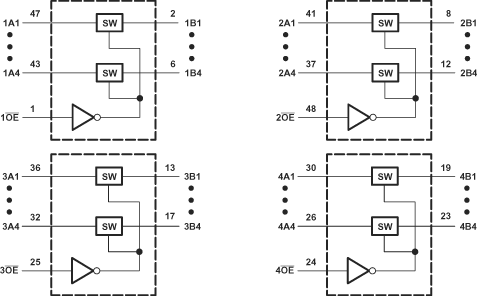SCDS168A May 2004 – September 2015 SN74CB3Q16244
PRODUCTION DATA.
- 1 Features
- 2 Applications
- 3 Description
- 4 Revision History
- 5 Description continued
- 6 Pin Configuration and Functions
- 7 Specifications
- 8 Parameter Measurement Information
- 9 Detailed Description
- 10Application and Implementation
- 11Power Supply Recommendations
- 12Layout
- 13Device and Documentation Support
- 14Mechanical, Packaging, and Orderable Information
Package Options
Refer to the PDF data sheet for device specific package drawings
Mechanical Data (Package|Pins)
- DGG|48
- DL|48
- DGV|48
Thermal pad, mechanical data (Package|Pins)
Orderable Information
9 Detailed Description
9.1 Overview
The SN74CB3Q16244 is part of the CB3Q family of switches. The SN74CB3Q16244 is a 16-bit FET bus switch in which 4 Output Enable pins each control a set of 4 switches totaling 16 switches.
 Figure 3. Simplified Schematic, Each FET Switch (SW)
Figure 3. Simplified Schematic, Each FET Switch (SW)
9.2 Functional Block Diagram
 Figure 4. Logic Diagram (Positive Logic)
Figure 4. Logic Diagram (Positive Logic)
9.3 Feature Description
The SN74CB3Q16244 device has a high-bandwidth data path (up to 500 MHz) and has 5-V tolerant I/Os with the device powered up or powered down. It also has low and flat ON-state resistance (ron) characteristics over operating range (ron = 5 Ω Typical)
This device also has rail-to-rail switching on data I/O ports for 0 to 5-V switching with 3.3-V VCC and 0 to 3.3-V switching with 2.5-V VCCas well as bidirectional data flow with near-zero propagation delay and low input and output capacitance that minimizes loading and signal distortion (Cio(OFF) = 4 pF Typical)
The SN74CB3Q16244 also provides a fast switching frequency (fOE = 20 MHz Maximum) with data and control inputs that provide undershoot clamp diodes as well as low power consumption (ICC = 1 mA Typical)
The VCC operating range is from 2.3 V to 3.6 V and the data I/Os support 0 to 5-V signal levels of (0.8-V, 1.2-V, 1.5-V, 1.8-V, 2.5-V, 3.3-V, 5-V)
The control inputs can be driven by TTL or 5-V and 3.3-V CMOS outputs, and Ioff supports partial-power-down mode operation.
9.4 Device Functional Modes
Table 1 lists the functional modes of the SN74CB3Q16244.
Table 1. Function Table
(Each Multiplexer/Demultiplexer)
| INPUT | INPUT/OUTPUT | FUNCTION | ||
|---|---|---|---|---|
| OE | A | |||
| L | B | A port = B port | ||
| H | Z | Disconnect | ||